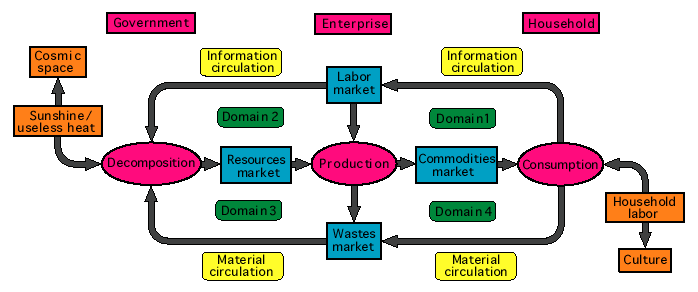TopPage>4 A METABOLISM MODEL
 |
Figure 5 A Metabolism Model |
TopPage>4 A METABOLISM MODEL
 |
Figure 5 A Metabolism Model |
The basic configuration of the economic system is designated as shown in Figure 5 A Metabolism Model, in conformity with the ecological system. The metabolism model was obtained by applying the Input-Output Relationships in Table1 to the Food-Chain Process in Figure 3. In the model, the internal mechanism of the production-consumption-decomposition processes (depicted as horizontal ovals in Figure 5) corresponds to that in Figure 4 The Principle of Heat Conversion; within these processes the conversion of economic components, shown in Table 2 Economic Components and Physical Elements, can be observed.
In the model shown by Figure 5, sunshine and household labor are the inputs, and useless heat and culture are the outputs with respect to the economic system. In terms of energy metabolism, there is an immense energy flow from the sun to cosmic space, as shown in Figure 6 A Representation of the Economic System. Material circulation starts with the decomposition system and also ends at the decomposition system, and is made up of portions contributing to the growth and maintenance of the economic system. As shown in the lower half of the model depicted in Figure 5, material circulation is basically confined within the economic process.
The circulation of information, however, starts with culture and ends with culture. As shown in the upper half of the model depicted in Figure 5, a part of the information flow contributes to the formation of the system and the remaining part is returned to the culture after circulating within the economic system itself. In this context, culture is a storage place for information, and evolution or progress means the process of information accumulation. Although economy is a part of culture, in this homepage culture is presented as being outside the economic process.
In the model depicted in Figure 5 and Figure 6 the flow of entropy, as indicated by the lower flow, is finally emitted into cosmic space in the form of useless heat. The water cycle plays a vital role in the process of entropy disposal because water by nature works as an entropy carrier. By introducing an entropy concept into the economic process, environmental issues can be accounted for within the framework of the economy.
In the metabolism model, the flow of money proceeds in a direction counter to that of the flow of substances (indicated by the arrows in Figure 5); i.e., money is always used in exchange for positive goods such as resources, commodities, and labor. In its counter-directional flow, money functions as an information carrier, specifying the positive goods to be exchanged.
Because wastes are negative (or less valuable) goods, waste disposal involves costs or requires that money be spent. In this connection, money proceeds in the same direction as the flow of these wastes. Because the exchange of money for negative goods is not a common practice, the government plays a role as a proxy for nature in disposing of these wastes. The basis of taxation is founded in this context, but taxation should be abolished through the advancement of technology that is expected to convert negative outputs into positive resources.